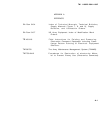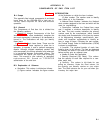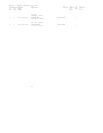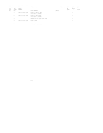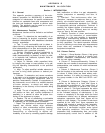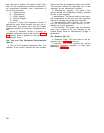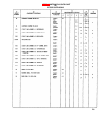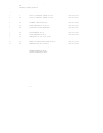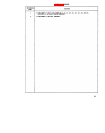APPENDIX D
MAINTENANCE ALLOCATION
Section l. INTRODUCTION
D-1. General
This appendix provides a summary of the main-
tenance operations for AN/USM-459. It authorizes
categories of maintenance for specific maintenance
functions on repairable items and components and
the tools and equipment required to perform each
function. This appendix may be used as an aid in
planning maintenance operations.
D-2. Maintenance Function
Maintenance functions will be limited to and defined
as follows:
a. Inspect. To determine the serviceability of an
item by comparing its physical, mechanical, and/or
electrical characteristics with established standards
through examination.
b. Test. To verify serviceability and to detect in-
cipient failure by measuring the mechanical or elec-
trical characteristics of an item and comparing those
characteristics with prescribed standards.
c. Service. Operations required periodically to
keep an item in proper operating condition; i.e., to
clean (decontaminate), to preseve, to drain, to paint,
or to replenish fuel, lubricants, hydraulic fluids, or
compressed air supplies.
d. Adjust. To maintain, within prescribed limits,
by bringing into proper or exact position, or by set-
ting the operating characteristics to the specified
parameters.
e. Align. To adjust specified variable elements of
an item to bring about optimum or desired per-
formance.
f. Calibrate. To determine and cause corrections
to be made or to be adjusted on instruments or test
measuring and diagnostic equipments used in
precision measurement. Consists of comparisons of
two instruments, one of which is a certified standard
of known accuracy, to detect and adjust any
discrepancy in the accuracy of the instrument being
compared.
g. Install. The act of emplacing, seating, or fixing
into position an item, part, module (component or
assembly) in a manner to allow the proper func-
tioning of the equipment or system.
h. Replace. The act of substituting a serviceable
like type part, subassembly, or module (component
or assembly) for an unserviceable counterpart.
i. Repair. The application of maintenance services
(inspect, test,
service, adjust, align, calibrate,
replace) or other maintenance actions (welding,
grinding, riveting,
straightening, facing,
remachining, or resurfacing) to restore ser-
viceability to an item by correcting specific damage,
fault, malfunction, or failure in a part, subassembly,
module (component or assembly), end item, or
system.
j. Overhaul.
That maintenance effort (ser-
vice/action ) necessary to restore an item to a com-
pletely serviceable/operational condition as
prescribed by maintenance standards (i.e., DMWR)
in appropriate technical publications. Overhaul is
normally the highest degree of maintenance per-
formed by the Army. Overhaul does not normally
return an item to like new condition.
k. Rebuild. Consists of those services/actions
necessary for the restoration of unserviceable
equipment to a like new condition in accordance
with original manufacturing standards. Rebuild is
the highest degree of materiel maintenance applied
to Army equipment. The rebuild operation includes
the act of returning to zero those age measurements
(hours, miles, etc.) considered in classifying Army
equipment/components.
D-3. Column Entries
a. Column 1, Group Number. Column 1 lists group
numbers, the purpose of which is to identify com-
ponents, assemblies, subassemblies, and modules
with the next higher assembly.
b. Column 2, Component/Assembly. Column 2
contains the noun names of components, assemblies,
subassemblies, and modules for which maintenance
is authorized.
c. Column 3, Maintenance Functions. Column 3
lists the functions to be performed on the item listed
in column 2. When items are listed without main-
tenance functions, it is solely for purpose of having
the group numbers in the MAC and RPSTL coin-
cide.
d. Column 4, Maintenance Category. Column 4
specifies, by the listing of a “work time” figure in
the appropriate subcolumn(s), the lowest level of
maintenance authorized to perform the function
listed in column 3. This figure represents the active
time required to perform that maintenance function
at the indicated category of maintenance. If the
number or complexity of the tasks within the listed
maintenance function vary at different maintenance
categories, appropriate “work time” figures will be
shown for each category. The number of task-hours
specified by the “work time” figure represents the
average time required to restore an item (assembly,
subassembly, component, module, end item or
system) to a serviceable condition under typical
field operating conditions. This time includes
preparation time, troubleshooting time, and quality
assurance/quality control time in addition to the
D-1





